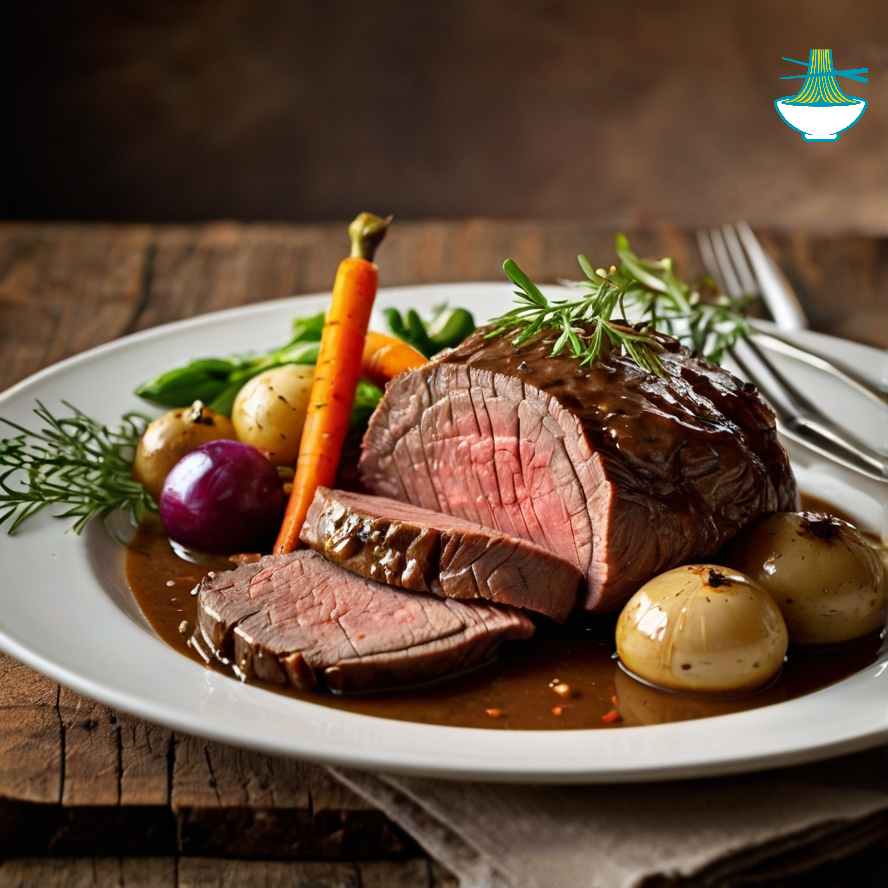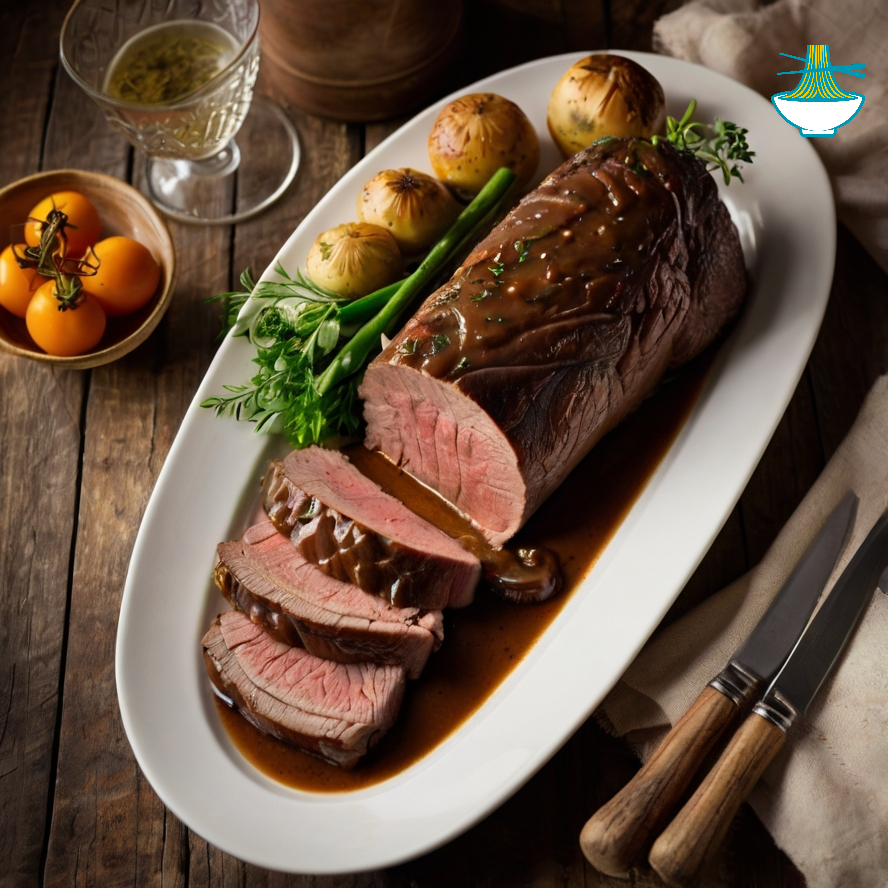Rinderbraten, a traditional German roast beef dish, is renowned for its tender meat and savory gravy. This dish is an excellent source of high-quality protein, which plays a vital role in muscle repair and growth. The accompanying gravy, often made from meat drippings, enhances flavor, while the vegetables provide essential vitamins, fiber, and antioxidants. Rich in minerals like iron and zinc, Rinderbraten supports immune function and overall health. However, due to its potentially high fat content, especially depending on the beef cut, it's best enjoyed in moderation. This well-balanced meal offers a combination of nutrients that help nourish the body effectively.
Ingredients:
- 2 lbs beef roast (preferably chuck or round)
- 2 tablespoons olive oil
- 1 large onion, chopped
- 2 cloves garlic, minced
- 2 carrots, chopped
- 2 celery stalks, chopped
- 2 cups beef broth
- 1/4 cup red wine (optional)
- 2 tablespoons flour (for gravy)
- Salt and pepper to taste
- Fresh thyme and rosemary sprigs
Ingredient Variations:
- Substituting Chicken Broth for Beef Broth: If you prefer a lighter version of Rinderbraten, you can substitute chicken broth for beef broth. This will reduce the richness of the dish without sacrificing too much flavor.
- Vegetable Alternatives: For a slightly different twist, you can add parsnips or turnips instead of carrots and celery. These root vegetables will complement the beef and provide additional earthy flavors.
- Wine Substitutes: If you’re avoiding alcohol, red wine can be omitted and replaced with more broth or a splash of balsamic vinegar for acidity and depth.
Instructions:
- Preheat the oven to 350°F (175°C).
- Heat the olive oil in a large ovenproof pot over medium-high heat. Season the beef roast with salt and pepper, then sear on all sides until browned.
- Remove the beef and set aside. In the same pot, sauté the onions, garlic, carrots, and celery until softened, about 5-7 minutes.
- Add the beef broth, red wine (if using), and herbs. Return the beef roast to the pot.
- Cover the pot and place it in the oven. Roast for 2-3 hours, or until the beef is tender and easily pulls apart with a fork.
- Remove the roast and let it rest before slicing.
- To make the gravy, strain the cooking liquid and return it to the pot. Whisk in the flour over medium heat until thickened, then season with salt and pepper to taste.
- Serve the roast beef with the gravy and vegetables.
Tips to Improve the Recipe:
- Adjusting Temperature and Cooking Time: The ideal cooking temperature for a beef roast like Rinderbraten depends on the type of beef used. For tougher cuts like chuck or round, slow roasting at lower temperatures (around 275°F or 135°C) for 3-4 hours can result in a more tender roast. If using a more tender cut like sirloin or tenderloin, a higher temperature (350°F or 175°C) for a shorter time is recommended, usually around 1.5-2 hours.
- Searing the Beef: Searing the roast on all sides before placing it in the oven helps lock in the flavors. For a deeper flavor, allow the beef to rest at room temperature before searing, and use a hot pan to get a golden brown crust.
Dietary Adjustments:
- Low-Fat Version: To make the recipe lower in fat, consider using leaner cuts of beef such as round or sirloin, and reduce the amount of olive oil used in searing. You could also use a small amount of vegetable oil instead of olive oil, though olive oil offers healthier fats.
- Vegetarian Version: For a vegetarian alternative, you can replace the beef with a hearty vegetable roast, such as a mix of mushrooms, eggplant, and zucchini. Substitute the beef broth with vegetable broth to maintain flavor.
Serving Suggestions:
- Rinderbraten pairs wonderfully with mashed potatoes, roasted vegetables, or a simple green salad. For a more festive touch, serve with a side of buttered noodles or a hearty potato gratin.
- Side Salad: A fresh, crisp green salad with a light vinaigrette would balance the richness of the beef and provide a refreshing contrast.
Frequently Asked Questions:
1. What is the best type of meat for preparing Rinderbraten?
- The best cuts for Rinderbraten are tougher, marbled cuts like chuck or round. These cuts become tender and flavorful when slow-cooked. For a more tender roast, consider using sirloin or tenderloin, although these cuts require less cooking time.
2. Can this dish be made in a slow cooker instead of the oven?
- Yes, you can cook Rinderbraten in a slow cooker. To do so, sear the beef as directed, then transfer it to the slow cooker with the vegetables, broth, and seasonings. Set the cooker on low for 6-8 hours or on high for 3-4 hours until the beef is tender and pulls apart easily with a fork.
3. What are healthy substitutes for butter or oil in the recipe?
- You can replace butter or olive oil with a smaller amount of avocado oil, which has a high smoke point and healthy fats. Alternatively, you could use vegetable broth to sauté the vegetables, which would reduce the fat content.
4. Can this dish be prepared in advance and stored?
- Yes, Rinderbraten can be made ahead of time. Once the roast is cooked, allow it to cool, then slice it and store the meat and gravy separately in airtight containers. It can be refrigerated for up to 3 days or frozen for up to 3 months. Reheat gently on the stovetop or in the oven.
5. What types of wine can be used in the recipe if I don’t want to use red wine?
- If you prefer not to use red wine, you can substitute with beef broth for a non-alcoholic version. Alternatively, balsamic vinegar can be used in place of wine to add acidity and depth to the sauce. If you want a wine alternative, you could use a non-alcoholic red wine or grape juice mixed with a splash of vinegar.
6. How can Rinderbraten be served for special occasions?
- For special occasions, consider serving Rinderbraten with elegant sides like roasted Brussels sprouts, creamy mashed potatoes, or a gourmet green bean almondine. You can also enhance the gravy with additional herbs such as thyme or bay leaves for extra flavor.

Nutritional values and benefits:
1. 2 lbs Beef Roast (908g, chuck or round)
- Calories: 1,400
- Carbohydrates: 0g
- Protein: 120g
- Fat: 100g
- Sodium: 120mg
- Cholesterol: 250mg
- Vitamins:
- Vitamin B12: 4.5mcg (75% DV)
- Vitamin B6: 0.6mg (30% DV)
- Minerals:
- Iron: 3.5mg (20% DV)
- Zinc: 9.5mg (64% DV)
- Benefit: Beef provides high-quality protein, supporting muscle repair and growth. It’s rich in vitamin B12, essential for red blood cell production, and iron, vital for oxygen transport in the blood. Zinc boosts immune function and supports wound healing.
2. 2 tablespoons Olive Oil (30g)
- Calories: 240
- Carbohydrates: 0g
- Protein: 0g
- Fat: 27g
- Sodium: 0mg
- Cholesterol: 0mg
- Vitamins:
- Vitamin E: 2.8mg (14% DV)
- Minerals:
- Iron: 0.6mg (3% DV)
- Benefit: Olive oil is rich in healthy monounsaturated fats that support heart health. It’s also a good source of vitamin E, an antioxidant that helps protect cells from oxidative damage and supports skin health.
3. 1 Large Onion (150g)
- Calories: 60
- Carbohydrates: 14g
- Protein: 1g
- Fat: 0g
- Sodium: 5mg
- Cholesterol: 0mg
- Vitamins:
- Vitamin C: 8.1mg (14% DV)
- Minerals:
- Potassium: 230mg (7% DV)
- Benefit: Onions are rich in antioxidants, which help reduce inflammation. Vitamin C supports immune health and skin health, while potassium aids in maintaining healthy blood pressure levels.
4. 2 cloves Garlic (6g, minced)
- Calories: 9
- Carbohydrates: 2g
- Protein: 0g
- Fat: 0g
- Sodium: 1mg
- Cholesterol: 0mg
- Vitamins:
- Vitamin C: 1mg (1% DV)
- Minerals:
- Manganese: 0.1mg (4% DV)
- Benefit: Garlic contains allicin, which has anti-inflammatory and antioxidant properties. It may help improve heart health, reduce cholesterol, and boost the immune system.
5. 2 Carrots (150g, chopped)
- Calories: 60
- Carbohydrates: 14g
- Protein: 1g
- Fat: 0g
- Sodium: 50mg
- Cholesterol: 0mg
- Vitamins:
- Vitamin A: 16,000 IU (320% DV)
- Minerals:
- Potassium: 350mg (10% DV)
- Benefit: Carrots are an excellent source of beta-carotene (vitamin A), which supports eye health. They also provide fiber for digestive health and potassium for heart and muscle function.
6. 2 Celery Stalks (100g, chopped)
- Calories: 16
- Carbohydrates: 3g
- Protein: 1g
- Fat: 0g
- Sodium: 80mg
- Cholesterol: 0mg
- Vitamins:
- Vitamin K: 30mcg (25% DV)
- Minerals:
- Calcium: 40mg (4% DV)
- Potassium: 260mg (7% DV)
- Benefit: Celery is rich in vitamin K, which supports bone health and proper blood clotting. It also contains antioxidants and anti-inflammatory compounds that promote overall health.
7. 2 Cups Beef Broth (480ml)
- Calories: 30
- Carbohydrates: 3g
- Protein: 4g
- Fat: 1g
- Sodium: 900mg
- Cholesterol: 5mg
- Vitamins:
- Vitamin B12: 0.2mcg (3% DV)
- Minerals:
- Iron: 1.5mg (8% DV)
- Benefit: Beef broth provides protein to support muscle repair and collagen for joint health. The iron content promotes red blood cell production and helps prevent anemia.
8. 1/4 cup Red Wine (optional, 60ml)
- Calories: 40
- Carbohydrates: 4g
- Protein: 0g
- Fat: 0g
- Sodium: 5mg
- Cholesterol: 0mg
- Vitamins:
- Vitamin C: 1.2mg (2% DV)
- Minerals:
- Potassium: 100mg (3% DV)
- Benefit: Red wine contains antioxidants such as resveratrol, which support heart health. It may also contribute to better circulation and promote healthy aging.
9. 2 tablespoons Flour (for gravy, 16g)
- Calories: 60
- Carbohydrates: 13g
- Protein: 1g
- Fat: 0g
- Sodium: 0mg
- Cholesterol: 0mg
- Vitamins:
- Folate: 45mcg (11% DV)
- Minerals:
- Iron: 1mg (5% DV)
- Benefit: Flour is used to thicken the gravy, adding texture and helping to carry the flavors. It provides energy through carbohydrates and a small amount of iron.
10. Salt and Pepper (to taste)
- Calories: Minimal
- Carbohydrates: 0g
- Protein: 0g
- Fat: 0g
- Sodium: Varies based on quantity
- Cholesterol: 0mg
- Vitamins:
- Sodium: 2300mg (100% DV for salt, but generally used in moderation)
- Benefit: Salt enhances the flavor of the dish, while pepper can have antioxidant properties and aid digestion.
11. Fresh Thyme and Rosemary Sprigs (1-2 sprigs each)
- Calories: Minimal
- Carbohydrates: 1g
- Protein: 0g
- Fat: 0g
- Sodium: Minimal
- Cholesterol: 0mg
- Vitamins:
- Vitamin C: 2mg
- Minerals:
- Calcium: 10mg
- Benefit: Fresh herbs like thyme and rosemary are rich in antioxidants and vitamins, supporting digestion and providing anti-inflammatory benefits.
Overall Benefit of Rinderbraten:
This dish offers a balance of protein, healthy fats, vitamins, and minerals. The beef provides essential protein and iron, while vegetables like carrots, celery, and onions add fiber, antioxidants, and vitamins. The olive oil and red wine contribute healthy fats and antioxidants for heart health, and the herbs support digestion and offer anti-inflammatory benefits. Rinderbraten is a rich, nutrient-dense meal that can be enjoyed as part of a healthy, balanced diet.


Comments